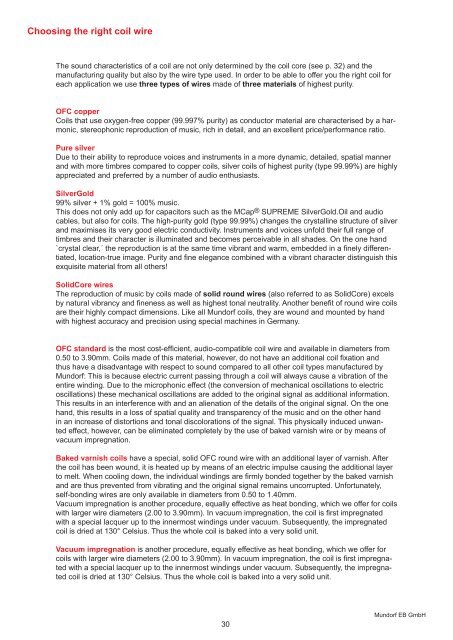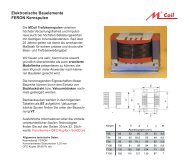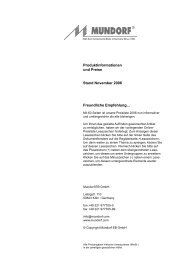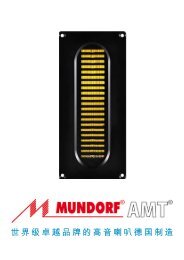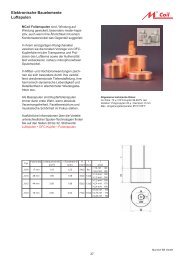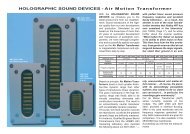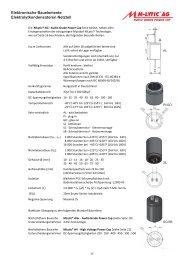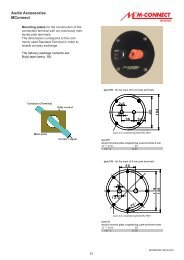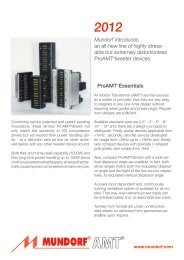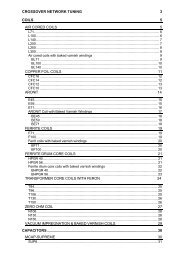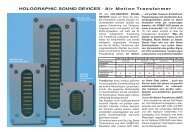26 Years for the Love of Music. Fidelity ... - Mundorf EB GmbH
26 Years for the Love of Music. Fidelity ... - Mundorf EB GmbH
26 Years for the Love of Music. Fidelity ... - Mundorf EB GmbH
Create successful ePaper yourself
Turn your PDF publications into a flip-book with our unique Google optimized e-Paper software.
Choosing <strong>the</strong> right coil wire<br />
The sound characteristics <strong>of</strong> a coil are not only determined by <strong>the</strong> coil core (see p. 32) and <strong>the</strong><br />
manufacturing quality but also by <strong>the</strong> wire type used. In order to be able to <strong>of</strong>fer you <strong>the</strong> right coil <strong>for</strong><br />
each application we use three types <strong>of</strong> wires made <strong>of</strong> three materials <strong>of</strong> highest purity.<br />
OFC copper<br />
Coils that use oxygen-free copper (99.997% purity) as conductor material are characterised by a harmonic,<br />
stereophonic reproduction <strong>of</strong> music, rich in detail, and an excellent price/per<strong>for</strong>mance ratio.<br />
Pure silver<br />
Due to <strong>the</strong>ir ability to reproduce voices and instruments in a more dynamic, detailed, spatial manner<br />
and with more timbres compared to copper coils, silver coils <strong>of</strong> highest purity (type 99.99%) are highly<br />
appreciated and preferred by a number <strong>of</strong> audio enthusiasts.<br />
SilverGold<br />
99% silver + 1% gold = 100% music.<br />
This does not only add up <strong>for</strong> capacitors such as <strong>the</strong> MCap® SUPREME SilverGold.Oil and audio<br />
cables, but also <strong>for</strong> coils. The high-purity gold (type 99.99%) changes <strong>the</strong> crystalline structure <strong>of</strong> silver<br />
and maximises its very good electric conductivity. Instruments and voices unfold <strong>the</strong>ir full range <strong>of</strong><br />
timbres and <strong>the</strong>ir character is illuminated and becomes perceivable in all shades. On <strong>the</strong> one hand<br />
`crystal clear,´ <strong>the</strong> reproduction is at <strong>the</strong> same time vibrant and warm, embedded in a fi nely differentiated,<br />
location-true image. Purity and fi ne elegance combined with a vibrant character distinguish this<br />
exquisite material from all o<strong>the</strong>rs!<br />
SolidCore wires<br />
The reproduction <strong>of</strong> music by coils made <strong>of</strong> solid round wires (also referred to as SolidCore) excels<br />
by natural vibrancy and fi neness as well as highest tonal neutrality. Ano<strong>the</strong>r benefi t <strong>of</strong> round wire coils<br />
are <strong>the</strong>ir highly compact dimensions. Like all <strong>Mundorf</strong> coils, <strong>the</strong>y are wound and mounted by hand<br />
with highest accuracy and precision using special machines in Germany.<br />
OFC standard is <strong>the</strong> most cost-effi cient, audio-compatible coil wire and available in diameters from<br />
0.50 to 3.90mm. Coils made <strong>of</strong> this material, however, do not have an additional coil fi xation and<br />
thus have a disadvantage with respect to sound compared to all o<strong>the</strong>r coil types manufactured by<br />
<strong>Mundorf</strong>: This is because electric current passing through a coil will always cause a vibration <strong>of</strong> <strong>the</strong><br />
entire winding. Due to <strong>the</strong> microphonic effect (<strong>the</strong> conversion <strong>of</strong> mechanical oscillations to electric<br />
oscillations) <strong>the</strong>se mechanical oscillations are added to <strong>the</strong> original signal as additional in<strong>for</strong>mation.<br />
This results in an interference with and an alienation <strong>of</strong> <strong>the</strong> details <strong>of</strong> <strong>the</strong> original signal. On <strong>the</strong> one<br />
hand, this results in a loss <strong>of</strong> spatial quality and transparency <strong>of</strong> <strong>the</strong> music and on <strong>the</strong> o<strong>the</strong>r hand<br />
in an increase <strong>of</strong> distortions and tonal discolorations <strong>of</strong> <strong>the</strong> signal. This physically induced unwanted<br />
effect, however, can be eliminated completely by <strong>the</strong> use <strong>of</strong> baked varnish wire or by means <strong>of</strong><br />
vacuum impregnation.<br />
Baked varnish coils have a special, solid OFC round wire with an additional layer <strong>of</strong> varnish. After<br />
<strong>the</strong> coil has been wound, it is heated up by means <strong>of</strong> an electric impulse causing <strong>the</strong> additional layer<br />
to melt. When cooling down, <strong>the</strong> individual windings are fi rmly bonded toge<strong>the</strong>r by <strong>the</strong> baked varnish<br />
and are thus prevented from vibrating and <strong>the</strong> original signal remains uncorrupted. Un<strong>for</strong>tunately,<br />
self-bonding wires are only available in diameters from 0.50 to 1.40mm.<br />
Vacuum impregnation is ano<strong>the</strong>r procedure, equally effective as heat bonding, which we <strong>of</strong>fer <strong>for</strong> coils<br />
with larger wire diameters (2.00 to 3.90mm). In vacuum impregnation, <strong>the</strong> coil is fi rst impregnated<br />
with a special lacquer up to <strong>the</strong> innermost windings under vacuum. Subsequently, <strong>the</strong> impregnated<br />
coil is dried at 130° Celsius. Thus <strong>the</strong> whole coil is baked into a very solid unit.<br />
Vacuum impregnation is ano<strong>the</strong>r procedure, equally effective as heat bonding, which we <strong>of</strong>fer <strong>for</strong><br />
coils with larger wire diameters (2.00 to 3.90mm). In vacuum impregnation, <strong>the</strong> coil is fi rst impregnated<br />
with a special lacquer up to <strong>the</strong> innermost windings under vacuum. Subsequently, <strong>the</strong> impregnated<br />
coil is dried at 130° Celsius. Thus <strong>the</strong> whole coil is baked into a very solid unit.<br />
30<br />
<strong>Mundorf</strong> <strong>EB</strong> <strong>GmbH</strong>


